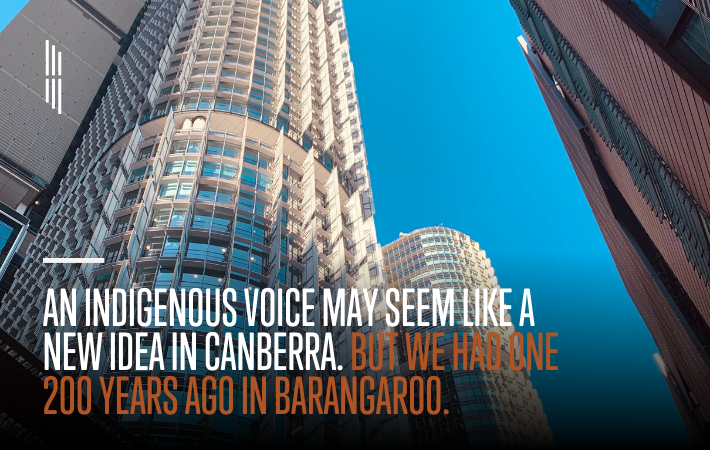Voice to Parliament

200 years before Barangaroo was a place she was a person; a matriarch of the Cammeraygal, traditional owners of much of the land round what we now call Sydney Harbour.
An independent leader in her own right, Barangaroo was also the wife of Bennelong, the first Aboriginal man to have dealings with the British.
The First Fleet’s leader, Arthur Phillip, had been instructed by King George III to treat the indigenous population of New South Wales with courtesy and respect. And Phillip knew that surviving even a few months in this harsh new environment would depend on gaining the trust of the people who called it home.
The connection he made with Bennelong grew into a close and enduring friendship. But his relationship with Barangaroo was entirely utilitarian. Innately suspicious of the newcomers, she could be openly critical of their behaviour, and was not afraid to interrupt Phillip’s council meetings to voice her concerns. Concerns which always prioritised her community’s interests over her own.
When she saw the British were killing more fish than they could eat, for example, she gave them what must have been one of the world’s first lectures on sustainability.
Governor Phillip listened to Barangaroo, and to Bennelong, and the counsel they provided was a strong influence on his administration of the fledgling colony. As a consequence of which, those first years of settlement were relatively peaceful, and relations with the indigenous locals were mainly good.
Tragically, few of the Governors who came after Phillip followed his example. And as more and more settlers annexed more and more land, the interests and welfare of its First Nations population were increasingly marginalised. Where there had once been cooperation there was coercion. Where there had been conversation there was confrontation – which all too often led to violence.
By the time we got around to independence relations had deteriorated to the point where the existence of Indigenous Australians wasn’t even acknowledged in our Constitution.
We didn’t start putting things right until the 1960’s, when more than 90% of Australians voted to confirm the democratic rights of Aboriginal and Torres Strait Islander people.
The Mabo land rights case of 1992 was another great milestone on the road to Reconciliation. As was Kevin Rudd’s 2007 Apology.
Establishing an Indigenous Voice to Parliament, the result of years of dialogue with thousands of First Nations people, is certainly as important as any of those events. But not all agree about the benefits it will offer.
Some see it primarily as a long overdue chance to right a serious – and internationally embarrassing – historical wrong. Others see it as a gateway to finding desperately needed solutions to the socio-economic problems which still plague many Aboriginal and Torres Strait Islander communities.
We’re sure that very few of the thousands of people who live and work at Barangaroo would disagree with either of those views. But as curators of a living monument to one of our First Nations’ most respected ancestors, we don’t see an Indigenous Voice to Parliament as an innovation.
We see it as an unmissable opportunity to resume a dialogue which began two centuries ago.
